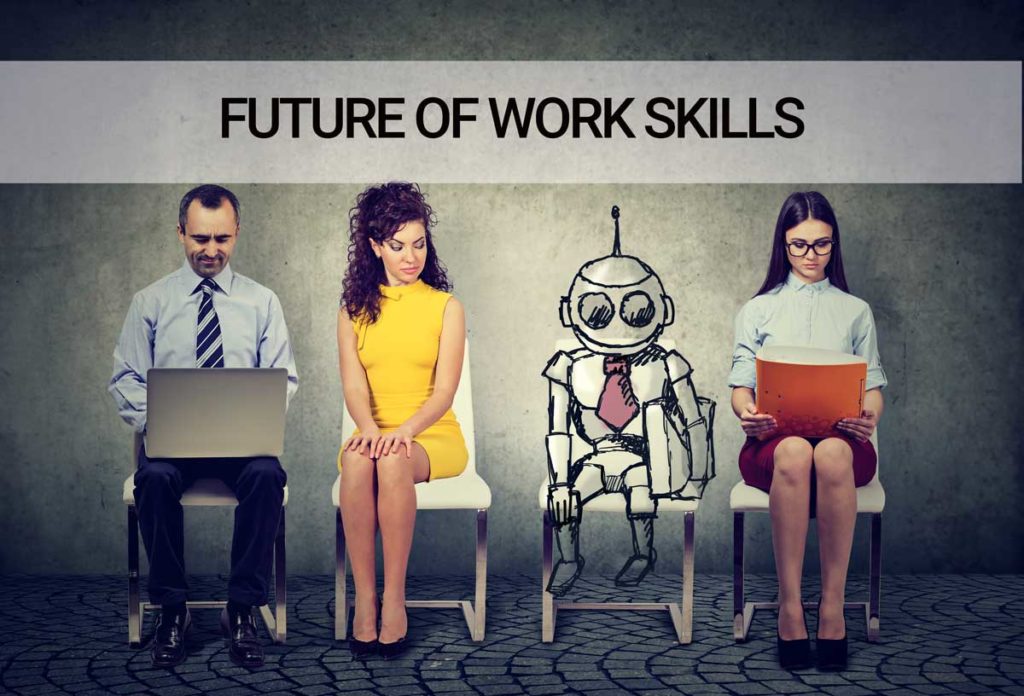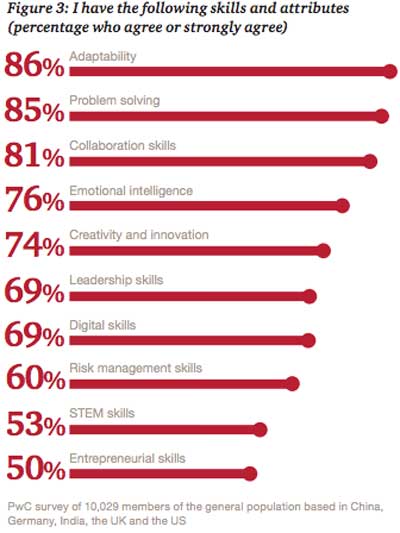What are the future of work skills for a turbulent and rapidly changing world is being hotly debated at the moment. Why? We are entering the fourth industrial revolution, one where machines, think artificial intelligence and robots, will replace jobs whilst creating new ones.
Some estimates talk about the huge swaths of people, up to 30% in the UK alone, that will be replaced by machines. There is no denying that we are in one of the most turbulent times in history. The digital world that we live in is transforming fast, as new technologies converge providing new business models and new value systems. A recent report indicates that 50% of the occupations that exist today will not exist 10 years from now.
The economy has become more service-oriented and increasingly digital, the importance of speed has increased dramatically. Those who can’t keep up fall will inevitably fall by the wayside. A recent study, by Tuck School of Business at Dartmouth College, shows that the five-year survival rates, for newly listed firms, has declined by 30% since the 1960s. But large organisations are equally at risk. Only 12% of fortune 500 companies still remain since 1995, whilst just over half of the names of companies on the Fortune 500 have disappeared since the year 2000.
The past remnants of our industrial era that have seen people in factories is being replaced by sophisticated robotics, intelligent and adaptive systems that learn and improve processes. The building block of the new knowledge economy is pipes of data which flow frictionless through the digital economy. These pipes are everywhere, connecting everything (think internet of things, mobiles), not only allow delivering commerce, but also redefining value. Value is now about connections. In the case of platforms they are creating new ways for connecting people products and services globally. The past industrial era is ending, hail the forth industrial era, the network economy.
There is an though an ever-widening gap between network-economy companies and those driven by traditional asset leverage models. The industrial economy was based on economies of scale within the organisation. The new focus is an outside-in approach to solving problems. The most important goal is to create a network structure where the value of all interactions is raised by all interactions; where every interaction benefits from the total number of interactions. The new workplace then is driven by connections, communications, collaborations and the value driven by the interactions.
The problem we face today though does not lie in the capabilities of humans, but in the outdated and limited perception of what workplaces should be and how work should be conducted. Much of the work is in fact ready for machines, for robots, not for human beings. The limiting factor of costs is disappearing as the technology accelerates, converges and becomes available at a lower and lower costs.
Are organisations ready for the change. Are they ready to adapt, rethink the workplace, rethink the future of works skills needed? In the US, 7 out of 10 people say they are dissatisfied at work, while 87% of people worldwide find themselves in jobs that don’t ask them to bring either their minds or their hearts to work. For more statistics like this see my earlier blog on employee engagement statistics. These demonstrate the potential for change, to harness a new way of working that embraces a more inclusive approach and design.
The Future of Work – What’s Driving The Change
In talking about technological change it’s important to understand the underlying principles. Two ‘laws’ underpin why the rapid adoption and dispersion of new technologies. Computing power continues to accelerate (Moore’s law), cloud computing enables fast and easy integration of processes through API’s, and storage costs have now is low cost and like computing power rented. The average costs of technology are falling. This is one of the key business drivers of today. The other is the ease in which new product and services can be created and therefore disrupt markets.
The building blocks are bigger as companies like Microsoft, Amazon and Google open up access to sophisticated platforms (AI as a service AIaaS and machine learning services (MLaaS)) for building applications. The price of technology is falling rapidly and the cost of starting a company has decreased dramatically. This in part accounts for the rise in platforms.
Combining elements of disintermediation, profit pool migration, globalisation, speed and customer transparency, many of these organisations are emerging as critical pivot points in their sectors. The new model is expanding across markets. Logistics, genetic sequencing, travel, order management, toys, customer relationship management software, consumer lending, digital advertising, payments, fashion, car rides, asset management, publishing—it might be easier to list industry sectors in which no one has yet thought to attempt a platform model.
Whilst many of may think of this technology as a long way off or only for big organisations, then you might be inspired by this story. A Japanese farmer who decided to sort cucumbers automatically to help his parents with what is a painstaking process. He didn’t have expertise in machine learning, nor a big budget. But he familiarised himself with TensorFlow and employed deep learning to recognise different sizes of cucumbers.
What Skills Will Be Needed In The Future?
H=In demand skills will of course be those that can harness and develop these technologies into products and services, the technical skills. But what about the broader set of skills across an organisation. The world economic forum has produced two reports which point to the effects of the global trends and their impact on the work place and work force. The Future Of Jobs report highlights the transition and reinforces that skills must change to meet the opportunities and challenges of the future.
Another report by the British innovation foundation Nesta and University of Oxford future-gazers from the Oxford Martin School tries to establish how those changes will affect skill requirements by 2030.
From the report, the top five desirable future work skills:
-
- Judgment and decision making: Considering the relative costs and benefits of potential actions to choose the most appropriate one.
- Fluency of ideas: The ability to come up with a number of ideas about a topic (the number of ideas is important, not their quality, correctness, or creativity).
- Active learning: Learning strategies—selecting and using training/instructional methods and procedures appropriate for the situation when learning or teaching new things.
- Learning strategies: Understanding the implications of new information for both current and future problem-solving and decision-making.
- Originality: The ability to come up with unusual or clever ideas about a given topic or situation, or to develop creative ways to solve a problem.
A recent report from PWC reinforces titled ‘The Workforce of the Future‘ confirms the same set of skills that will be needed to work in an environment where machines and humans interact.
Already 37 percent of the global workforce is now mobile, 30 percent of full-time employees now do most of their work outside of the employers’ location, and 20 percent of the workforce is composed of temporary workers, contractors, and freelancers. Communication and collaboration will only increase as those in the workforce become more “untethered” and fluid in the roles they undertake and in their interactions with others.
The fundamental ways in which we work will reflect a more organic ecosystem. Organisations will be intrinsically linked, networked through complex but adaptive value systems to each other. Human will likewise need to be highly adaptive, able to work with and across different types of teams. The new management challenge will be to identify the patterns of interaction behind high or low productivity and high or low creativity.
Developing Skills and Competing For Talent
Educational Foundations
Compare a jobs board in 2018 with its equivalent a decade ago, and you can’t help noticing that businesses require an entirely different skillset than they did previously. Fast forward to 2030 and it is easy to imagine that the jobs (if advertised at all) will bear little resemblance to those of today. But our need to prepare for this future does start today.
Ken Livingston has pointed out that our educational institutions are not strategically designed to provide the talent needed for these skills (in particular creativity). Many already are questioning in fact how our educational institutions themselves need to adapted for the 21st C student experience. If our educational institutions are not already preparing the next generation for the future then we already have a bottle neck for future skills. Our education systems, like many organisations, are feeling the impact of the societal and technological changes. Generations are coming through questioning the value of their investment in education as the way they network, collaborate and communicate is not reflected in the educational institutions.
Within the academic world, a semantic and definitional debate is already raging about how to classify soft skills and what to call them. 21st century skills, non-cognitive traits and habits, social and emotional skills, growth mindsets, grit, soft skills—these terms are all slightly different, but often used interchangeably to describe an overlapping set of skills.
Education researcher Ellen Galinsky identified seven essential life skills that encompass most of the soft skills necessary for the future or work. They are:
- Focus and self-control
- Perspective taking
- Communicating
- Making connections
- Critical thinking
- Taking on challenges
- Self-directed, engaged learning
Preparing the Organisation
The imperative for leaders now is to strategically build a more adaptable organisation. Technologies do not just create new kinds of jobs, they also change the way work is organised, managed and controlled.
What is so remarkable is that there are so many possible ways of organising our experience of working together. There needs to be a shift in thinking about work to a shared life, a hared experience. Time is the most valuable human asset. It is time that is our scarcest asset. Most workers spend more time at work (often unengaged and unhappy) than with their family and closest friends. It is time to think of work as a shared experience a shared life. The shoots of change are happening.
Lifestyles are becoming work styles. Diversity is increasing. More and more people are seeking novel ways to earn a living. More and more often the way to do work is a combination of human creativity and software. Humans want to work above the app, not below it. We don’t serve the machines, but the machines serve us. The pace is dictated by people, not the assembly line. Learning is the new word for productivity. The point of learning relationships is that they allow people to create value together. This is the foundation of the networked economy.
The underlying factors of how an organisation creates value are changing; in order to adapt, organisations must begin to think of themselves as service marketplaces and service market makers (the organisation as a platform). Leaders need to accept that their source of value creation is their network reach and richness. Maximising network interactions, developing a collective and collaborative intelligence becomes the route to maximising value.
Future success will be defined by people and machines, but now is the time to prepare the organisation. The seeds of an adaptive organisational are founded in the following:
- understand and make data and insights available – openness and being able to combine data is critical it’s creative use and transformation to value
- what can be done with it – not only for efficiency and productivity gains for value creation – new business models
- understand networks and network topology
- understand contextualisation of the relationships in their value chain
- identifying relationships and influence can help increase the rate of change internally e.g. change champions
- identify weaknesses and opportunities in the network for value creation – partners, suppliers, competitors…
- understand the new tools that can be created / used to develop a more fast, nuanced and connectivity
- understand how to build business models in this context
- understand the new key metrics for the new models
- institute new reporting and management that does not lead to CFIT
The new operating system of work that is evolving before our eyes as an opportunity to build something better. The case for humans is the need to develop people both as individuals, within teams and as an organisation.





